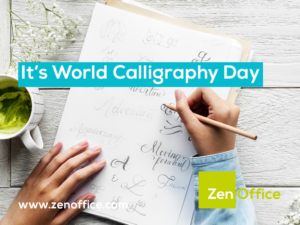
Considered an art form in Asian and Middle Eastern cultures, the practice of calligraphy is as highly regarded as it is beautiful. It has enjoyed a boom in popularity in recent years, transcending wedding invitations to being featured in branding, contemporary typography and digital design. If you enjoy watching the many oh-so satisfying calligraphy videos that can be found around the web as much as we do, you might be interested to know a little more about this ancient art.
• The English word calligraphy is derived from the Ancient Greek words ‘Kallos’ and ‘Graphein’ meaning ‘beauty’ and ‘to write’.
• Calligraphy originated in China between 4000-5000 years ago, before spreading throughout the Orient with Chinese culture.
• The Chinese traditionally use a bamboo brush to practice calligraphy with the head being typically made from animal hair such as weasel, rabbit, deer, goat, pig, tiger and wolf. Newborn human hair can also be used to create a once in a lifetime souvenir brush for luck.
• Japanese calligraphy influences and is influenced by Zen thought in Buddhism, where the act of writing letters is spiritual and the outcome is a reflection on the calligrapher’s mental state at the time.
• Western calligraphy developed a much more structured and uniform style, often practised for copying religious texts. During the Middle Ages, manuscripts were often highly decorative, featuring gold lettering and fine paintings.
• Birmingham’s roaring pen trade in the 1800s significantly contributed to the development of education and literacy around the world. The skilful and cheap manufacture of steel-pen nibs meant that by 1850 Birmingham was responsible for more than half of steel-nib pens made globally.
• Did you know you can learn calligraphy yourself online for free? Check out this tutorial to get you started.